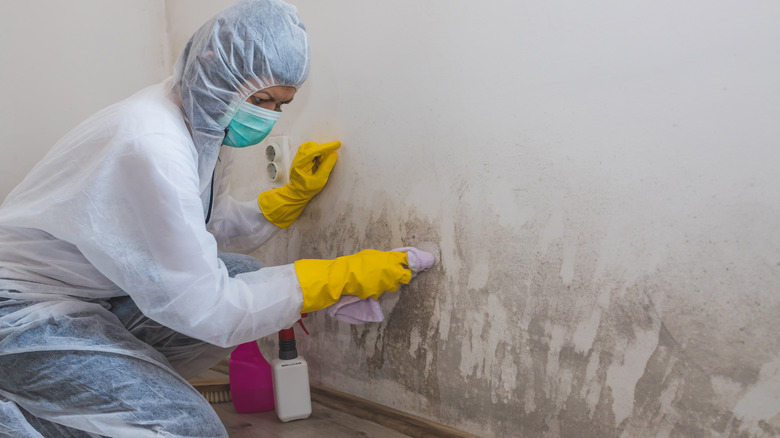What It Could Mean If Paint Is Bubbling In Your House
Painting is a complex task in any home environment. The application of a new coat of paint should be completed inside the home every three to five years, according to PaintRite Pros. Yet, the task of painting a home involves more than simply rolling on a new coat to fit with modern color and sheen trends.
When applying a new paint job to the walls, it's a common sight to see some minor bubbling as the paint dries (via Family Handyman). If the bubbles persist after a few days though, you can quickly spot that something is amiss in the finished product. Bubbling or blistering paint is most often the result of an improperly prepared surface, and it can be costly to repair the damage—it will likely require a new paint job that starts from scratch.
While a well-prepared surface can eliminate the vast majority of potential problems involving bubbling paint, this isn't the only factor that can cause the phenomenon. Mold growth that exists beneath the surface of the wall thrives in spaces exposed to intense moisture for elongated periods, like basements that play host to a washer and dryer, or the walls of the bathroom. Family Handyman reports that mold—either toxic or a more routine variety—can act as the cause of bubbling paint, while the CDC recommends treating all mold growth in the home as if it were toxic in order to maintain safe health standards.
Many elements can affect the adherence of your new paint
Family Handyman reports that old paint, moisture, dirt, and other debris that naturally adheres to walls over time can act as the primary source of this bubbling effect after a fresh coat of paint is applied inside the home.
While a uniform coat of paint is always important for getting the walls to look beautiful and vibrant, preparing the surface—or substrate—before adding any new paint is perhaps the most important step in the whole process. Scraping away old paint and sanding down imperfections on the surface of the wall will set apart a great paint job from a good one. Likewise, if your wall feels damp or moist, you should take steps to dry out the surface before painting in order to ensure that a quality coat dries in place once you do finally add the new paint. Tapco HomeDry offers a few easy-to-use solutions for drying out a damp wall that isn't yet fit to be painted.
If you do miss a few spots and find yourself needing to fix some bubbling in the wall, the process simply involves starting over and repainting the section. Scraping away the paint, sanding, drying, and preparing the surface for a new coat is all it will take to fix the issue. That being said, great care should be taken to ensure that the surface is prepared meticulously to avoid needing a third attempt at the section.
Mold growth should always be taken seriously
If your paint is pulling away from the wall's surface after the substrate has been carefully cleaned, dried, and otherwise prepared for the fresh coat, then you may be dealing with a mold issue rather than a poorly prepared painting surface. Mold should always be taken extremely seriously, according to the CDC, because the difference between a toxic variety and one that's benign is often so slight that misidentification is entirely possible among untrained homeowners.
Mold grows as a result of high moisture content in the air. This feature makes for a similar outcome when painting the interior of a home. Looking for these distinct bubble patterns that continue to appear, even after the surface has been prepared with caution and heightened focus, can clue you in to whether you're dealing with a simple issue or a larger, mold-related one.
The substance reproduces, expanding across a wall or ceiling through spores that are carried from surface to surface by air currents (via Wet and Forget). Mold growth can either expand across the visible surface of the wall or within or behind the drywall or plaster exterior. This makes the issue hard to identify in certain circumstances. Family Handyman reports that a diluted bleach and water mixture can help you identify mold growth on a wall or other surface of the home. If the spot lightens upon application, it's likely that you're dealing with mold.


